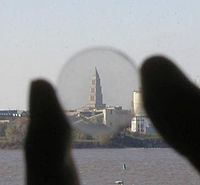
Photo from wikipedia
This paper takes into consideration the performance of traditional bricks as part of a building exterior wall finish. Exterior wall materials change their properties when exposed to external environment. This… Click to show full abstract
This paper takes into consideration the performance of traditional bricks as part of a building exterior wall finish. Exterior wall materials change their properties when exposed to external environment. This process is extended over time and its intensity is closely related to microstructure, moisture and freeze–thaw cycles. Two methods of freeze–thaw durability tests were used in this study: standard and defined by the authors. The authors’ method incorporated the actual conditions of masonry unit function in exterior wall finish, i.e., cyclical effects of precipitation water, changes in temperature and air humidity. The laboratory test study included 50 freeze–thaw cycles. Three characteristic ranges of pore dimensions were indicated in the analysis: below 0.1 µm, between 0.1 and 3.0 µm and above 3 µm. Based on the method of freeze–thaw durability testing, the areas of microstructure changes were determined. The obtained results were related to the absorption of ceramic building materials. The authors’ method confirms the usage of traditional ceramic building materials designed for use in protected walls against water penetration in unprotected exterior wall finish. The critical water saturation method of masonry units (standard) based on extreme environmental conditions generates significant changes in porosity distribution that do not reflect real, i.e., moderate, conditions. This method is appropriate for masonry units operating in severe conditions, i.e., F2. The aim of this study is to suggest a methodology for durability tests of traditional ceramic masonry units to cyclic freezing and thawing, which are only exposed to F1 (moderate) conditions during operation. Changes in the microstructure of the ceramic building materials were used as the primary evaluation criterion. In order to determine the effect of cyclic temperature changes, the freeze–thaw durability test was performed according to generally accepted standard procedures and in-house methodology. The purpose of the study is to point out the individual approach for the analysis of the material–environment system. At the same time, it should inspire researchers to innovative methods which use external conditions in a laboratory environment.
Journal Title: Materials
Year Published: 2022
Link to full text (if available)
Share on Social Media: Sign Up to like & get
recommendations!